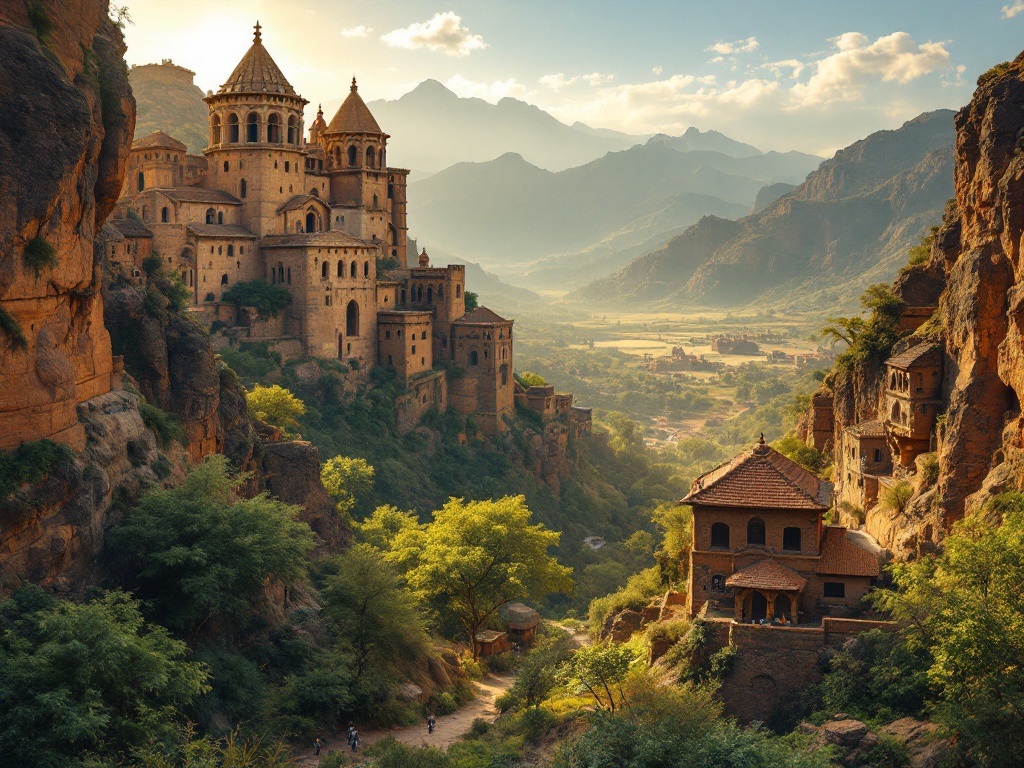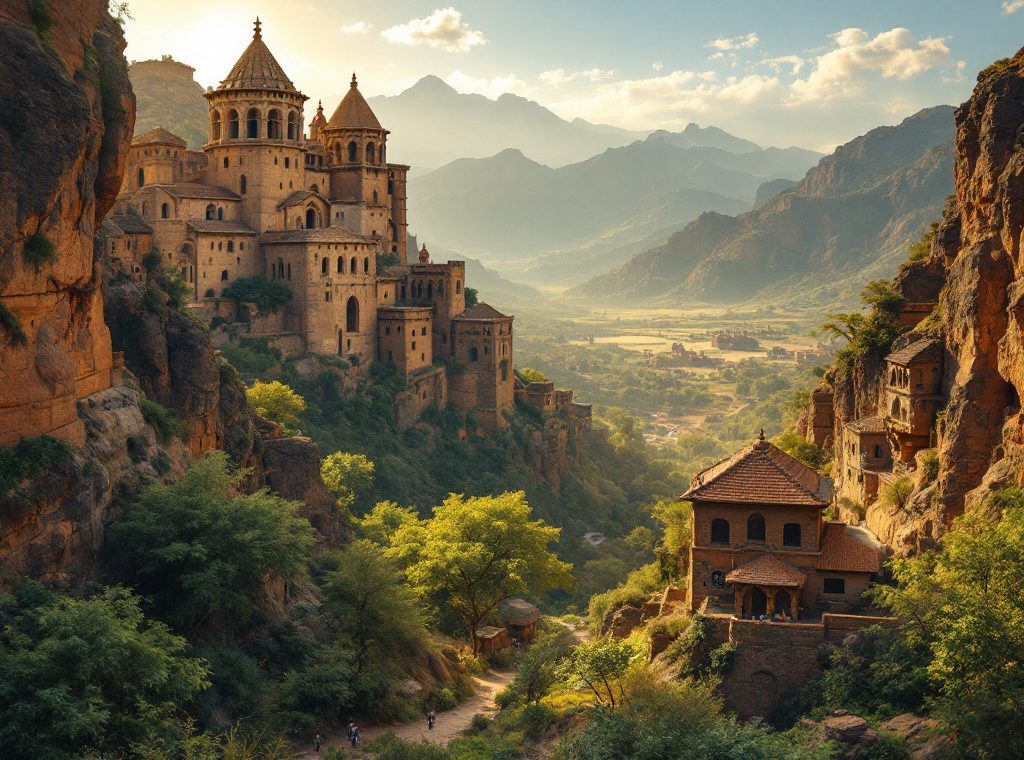Exploring Ethiopia’s Historical Sites: A Travel Guide
Unlock the mysteries of Ethiopia’s ancient wonders! Journey through time exploring the rock-hewn churches of Lalibela, the castles of Gondar, and the obelisks of Aksum. Discover nine UNESCO World Heritage sites, from the cradle of humankind in the Omo Valley to the breathtaking Simien Mountains. Plan your unforgettable adventure with our guide to the best time to visit, practical travel tips, and diverse tour options. Explore Ethiopia’s rich history and vibrant culture today!
Important information

- Ethiopia boasts nine UNESCO World Heritage Sites, including the rock-hewn churches of Lalibela, the castles of Gondar (Fasil Ghebbi), and the ancient city of Aksum.
- Aksum is a significant religious center, possibly housing the Ark of the Covenant in the Church of Our Lady Mary of Zion.
- The dry season (October to May) is the best time to visit Ethiopia for optimal weather.
- Visitors should obtain a visa and necessary vaccinations before traveling.
- Hiring local guides can enhance the travel experience by providing valuable insights into Ethiopia’s rich history and culture.
Exploring Ethiopia’s Historic Sites
Journey through Ethiopia, a land of captivating history. Explore the rock-hewn churches of Lalibela, wander through the Gondar castles, and uncover the secrets of ancient Aksum. These remarkable landmarks showcase Ethiopia’s rich heritage and historical significance. Ethiopia’s dedication to preservation allows visitors to experience this history firsthand, forging a powerful connection to the past. Discover the following historical treasures:
- Rock-hewn Churches of Lalibela: These monolithic churches are a testament to architectural ingenuity and religious devotion, carved directly from the rock.,
- Gondar Castles: Explore the royal enclosure of Gondar, featuring impressive castles and palaces that reflect Ethiopia’s imperial past.,
- Ancient Aksum: Uncover the mysteries of the ancient Aksumite kingdom, with its towering obelisks and archaeological wonders.
UNESCO World Heritage Sites in Ethiopia
Ethiopia is a land of captivating history and breathtaking landscapes, home to nine UNESCO World Heritage Sites. Journey through time exploring architectural marvels, ancient obelisks, and traces of early human history.
Historical Treasures
- Lalibela’s Rock-Hewn Churches: marvel at the intricate architecture carved directly into the rock face.
- Fasil Ghebbi: explore the royal enclosure of Gondar, a fascinating complex of castles and palaces.
- Axum: discover the ancient obelisks, towering monuments that mark the heart of this historic city.
- Harar Jugol: wander through the walled city, a unique blend of Islamic and African cultures.
Natural Wonders and Cultural Landscapes
- Lower Awash and Omo Valleys: step back in time to the cradle of humankind, where evidence of early human history abounds.
- Simien National Park: witness breathtaking mountain vistas, home to diverse wildlife and dramatic landscapes.
- Tiya: uncover the mystery of the ancient stelae, enigmatic stone markers scattered across the landscape.
- Konso Cultural Landscape: delve into the unique agricultural traditions of the Konso people and their terraced hillsides.
These nine UNESCO World Heritage Sites offer a glimpse into Ethiopia’s incredible heritage, showcasing the country’s rich history, diverse cultures, and stunning natural beauty.
Rock-Hewn Churches of Lalibela
Lalibela’s eleven rock-hewn churches, carved from red volcanic rock, are a magnificent testament to 13th-century Ethiopian architecture and deep religious devotion. These remarkable monolithic structures are recognized as a UNESCO World Heritage site.
Lalibela: Monolithic Churches
Lalibela is renowned for its extraordinary rock-hewn churches. Eleven monolithic structures, carved directly from solid rock in the 12th century, stand as testaments to artistic ingenuity and religious devotion. King Lalibela envisioned the site as a “New Jerusalem”. Today, this UNESCO World Heritage site thrives as a vital center of Ethiopian religious life. The churches showcase the remarkable engineering feats and profound artistry of the era, making them a truly awe-inspiring sight.
The Ancient City of Axum
Axum, a UNESCO World Heritage Site, is profoundly important as the holiest city in the Ethiopian Orthodox faith. This ancient metropolis, once the thriving center of the Aksumite Empire, boasts impressive obelisks and royal tombs. It is even rumored to house the Ark of the Covenant. A vital trade hub connecting Africa and the Arabian Peninsula, Axum’s archaeological treasures reveal a rich history dating back to the 1st century AD. It’s a truly remarkable destination.
The Ruins of Aksum
The ruins of Aksum whisper tales of a powerful empire that flourished from the 1st to the 7th centuries CE. Towering obelisks dominate the landscape, remnants of a civilization that thrived as a vital trading hub connecting Africa with Arabia and beyond. Royal tombs and crumbling palaces further evoke this bygone era, while the city’s early adoption of Christianity highlights a pivotal cultural transformation. Aksum’s remarkable ruins stand as a testament to its enduring legacy.
Fasil Ghebbi: The Historical Castle
Gondar, Ethiopia’s Fasil Ghebbi, a UNESCO World Heritage site, is a remarkable fortified complex. It showcases a blend of Nubian, Arab, and Indian architectural styles. Its castles and palaces once housed Emperor Fasilides and his successors during the 17th and 18th centuries. Within its walls lie libraries and archives, as well as impressive structures like the Iyasu I and Dawit III Palaces.
Gondar Castles: The Royal Capital
Gondar, Ethiopia’s 17th-century capital, is famous for its magnificent castles and palaces, lasting monuments to the country’s emperors. This royal compound displays a unique blend of Portuguese, Indian, and traditional Ethiopian architecture. Among the impressive structures is Fasil Ghebbi. Designated a UNESCO World Heritage site, the Gondar castles offer a truly remarkable spectacle.
Religious and Cultural Sites
Axum is a deeply religious city, renowned as the birthplace of the Ethiopian Orthodox Tewahedo Church. Among its significant sites is the Church of Our Lady Mary of Zion, reputed to house the Ark of the Covenant. Another remarkable site, though requiring a challenging climb, is Abune Yemata Guh, a testament to the worshippers’ profound devotion. Don’t forget that most visitors to Ethiopia require an eVisa. You can apply for one at eVisa Ethiopia.
Axum: Birthplace of Ethiopian Orthodox Church
Axum, the heart of the Ethiopian Orthodox Tewahedo Church, is a vital pilgrimage site for followers of this ancient Christian faith. Many journey there to visit the Church of Our Lady Mary of Zion, believed to house the Ark of the Covenant, further enhancing its sacred significance.
Church of Our Lady Mary of Zion
Located in Axum, Ethiopia, the Church of Our Lady Mary of Zion is a revered site for the Ethiopian Orthodox Tewahedo Church, believed by many to house the Ark of the Covenant.
Abune Yemata Guh Church
Hidden within Ethiopia’s Tigray Region lies the extraordinary Abune Yemata Guh Church. Carved into a sheer cliff face high above Hawzen, this rock-hewn sanctuary offers a thrilling adventure for visitors. The ascent demands a daring climb up the rock walls, but the breathtaking views and glimpse of beautifully preserved murals within await those who conquer the challenge.
Sacred and Archaeological Sites
Ethiopia, a land of ancient wonders, invites exploration. Among its treasures is the rock-hewn Yemrehana Krestos Church in Lalibela. In Axum, the Church of Our Lady Mary of Zion stands, its Chapel of the Tablet believed to protect the Ark of the Covenant. A unique ascent awaits those seeking the Monastery of Debre Damo, accessible only by rope, perched high on a flat-topped mountain. Nearby, Axum’s Northern Stelae Park displays towering obelisks, vestiges of the powerful Axumite kingdom, each a testament to Ethiopia’s rich past.
Yemrehana Krestos Church
Yemrehana Krestos Church is a stunning example of Axumite architecture, seamlessly blending wood and stone. It is located in Gheralta, within Ethiopia’s Tigray region. This ancient church predates Lalibela’s renowned rock-hewn structures. Nestled within a cave, its unique layers of wood and granite distinguish it from other Ethiopian rock-hewn churches, making it a true architectural marvel.
Chapel of the Tablet
Near Ethiopia’s Church of Our Lady Mary of Zion in Axum, the Chapel of the Tablet holds profound significance for Ethiopian Orthodox Tewahedo believers. They venerate it as the repository of the Ark of the Covenant, a belief imbuing the chapel with immense sanctity.
Monastery of Debre Damo
Perched atop a sheer Ethiopian cliff, the Monastery of Debre Damo presents a unique challenge: access is only possible by rope. This daunting ascent underscores the profound religious importance of this ancient site, a centuries-old hub of monastic tradition and a powerful symbol of unwavering faith.
Northern Stelae Park
The Northern Stelae Park in Axum, Ethiopia, showcases towering carved obelisks, or stelae, that mark the tombs of Axumite royalty. These impressive monuments stand as a testament to the empire’s powerful and prosperous past. The largest stela reaches an incredible height of 24 meters.
Historic Towns and Landmarks
Embark on a journey to Harar, a walled medieval city in eastern Ethiopia, renowned for its unique architecture and rich culture. For a different kind of adventure, travel to Bahir Dar, situated on the southern shore of Lake Tana. This city serves as a gateway to Ethiopia’s historical wonders, including the Island Monasteries dispersed across the lake. Bahir Dar is also an ideal starting point for trips to the magnificent Blue Nile Falls.
Harar: A Medieval Walled Town
Harar, a walled city in eastern Ethiopia, presents a unique blend of architecture, history, and tradition. Famous for its over 100 mosques and numerous shrines, it holds a significant position as an Islamic center. Harar is also known for its nightly hyena feeding ritual. This generations-old practice involves local men hand-feeding wild hyenas, offering a remarkable spectacle.
The Mystery of the Hyenas
The origins of this daring tradition, now a popular tourist attraction, remain shrouded in mystery. Some believe it began as a way to appease the hyenas and protect the city’s livestock.
Divination and Wildlife
Others posit that it was a method of divining the future by interpreting the hyenas’ behavior during feeding. Regardless of its true beginnings, the ritual provides a unique insight into the complex relationship between humans and wildlife.
The city’s ancient walls stand as a testament to Harar’s rich cultural heritage, whispering stories of bygone eras. This unique blend of history, tradition, and wildlife makes Harar a truly remarkable destination.
Bahir Dar: Gateway to Historical Circuit
Bahir Dar, the gateway to Ethiopia’s Historic Route, offers easy access to Lake Tana and the stunning Blue Nile Falls. Nearby, explore the Gondar castles and the remarkable rock-hewn churches of Lalibela. It’s the perfect starting point for an unforgettable Ethiopian adventure.
Practical Tips for Visiting Ethiopia
Plan your trip to Ethiopia during the dry season, from October to May, for ideal travel weather. Before you go, secure your visa and check recommended vaccinations. Hiring local guides can enrich your understanding of Ethiopia’s history and culture. Dress respectfully, especially when visiting religious sites. Learning basic Amharic phrases will enhance your interactions with locals.
Travel Tips
- Book transport and accommodation in advance for a smoother trip.
- If traveling to mountainous areas like Lalibela, be prepared for potential altitude sickness and acclimatize gradually.
- Respect local customs throughout your journey.
Exploration Styles
Guided tours provide structure and convenience, while independent exploration offers greater flexibility. Combine both for a balanced experience: join a guided tour of historical sites and then independently explore local markets. Consider timing your visit with a local festival for a unique cultural immersion.
Best Time to Visit
Ethiopia’s Dry Season (October – March)
Discover Ethiopia’s historical wonders during the dry season, spanning from October to March. This period offers perfect weather with less rain and comfortable temperatures, making exploration enjoyable. The months from November to February are especially popular, coinciding with vibrant cultural festivals.
Ethiopia’s Rainy Season (June – September)
Experience a more intimate side of Ethiopia during the rainy season, from June to September. While it attracts fewer tourists, access to some sites might be limited due to rainfall.
Travel and Safety Tips
Planning your trip to Ethiopia is crucial for a fulfilling experience. Before you go, research the historical sites and their cultural significance. Dress respectfully, particularly when visiting religious places. Learning basic Amharic phrases will enhance your interactions with the local people. Consider hiring local guides for a deeper understanding of the culture and history.
Safety and Health
Prioritize your safety by reviewing travel advisories and visa requirements. Consult your doctor about recommended vaccinations and health precautions, especially concerning altitude sickness if you plan to visit Lalibela. Pack clothing suitable for diverse climates, from the cooler highlands to the warmer lowlands.
Local Conditions and Backup Plans
Stay informed about local conditions and engage reputable guides for your travels. Always have backup plans in place to address any unforeseen circumstances. With thorough preparation, you can maximize your enjoyment of your Ethiopian adventure.
Types of Tours Available
Explore












